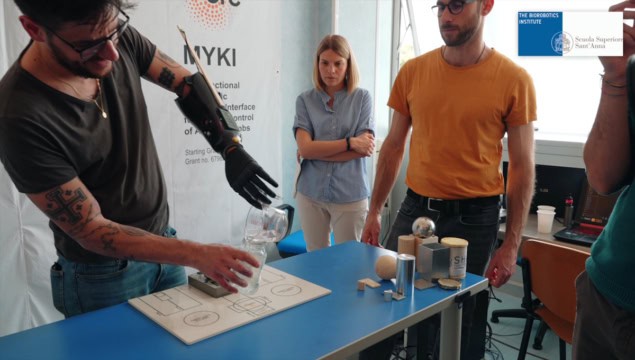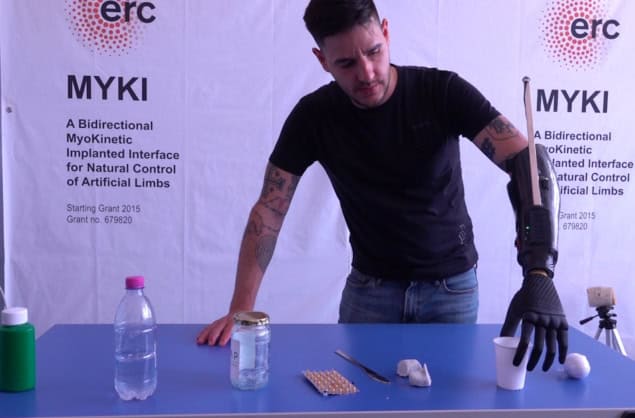
A magnetically controlled prosthetic hand, tested for the first time in a participant with an amputated lower arm, provided fine control of hand motion and enabled the user to perform everyday actions and grasp fragile objects. The robotic prosthetic, developed by a team at Scuola Superiore Sant’Anna in Pisa, uses tiny implanted magnets to predict and carry out intended movements.
Losing a hand can severely affect a person’s ability to perform everyday work and social activities, and many researchers are investigating ways to restore lost motor function via prosthetics. Most available or proposed strategies rely on deciphering electrical signals from residual nerves and muscles to control bionic limbs. But this myoelectric approach cannot reproduce the dexterous movements of a human hand.
Instead, Christian Cipriani and colleagues developed an alternative technique that exploits the physical displacement of skeletal muscles to decode the user’s motor intentions. The new myokinetic interface uses permanent magnets implanted into the residual muscles of the user’s amputated arm to accurately control finger movements of a robotic hand.
“Standard myoelectric prostheses collect non-selective signals from the muscle surface and, due to that low selectivity, typically support only two movements,” explains first author Marta Gherardini. “In contrast, myokinetic control enables simultaneous and selective targeting of multiple muscles, significantly increasing the number of control sources and, consequently, the number of recognizable movements.”
First-in-human test
The first patient to test the new prosthesis was a 34-year-old named Daniel, who had recently lost his left hand and had started to use a myoelectric prosthesis. The team selected him as a suitable candidate because his amputation was recent and blunt, he could still feel the lost hand and the residual muscles in his arm moved in response to his intentions.
For the study, the team implanted six cylindrical (2 mm radius and height) neodymium magnets coated with a biocompatible shell into three muscles in Daniel’s residual forearm. In a minimally invasive procedure, the surgeon used plastic instruments to manipulate the magnets into the tip of the target muscles and align their magnetic fields, verifying their placement using ultrasound.
Daniel also wore a customized carbon fibre prosthetic arm containing all of the electronics needed to track the magnets’ locations in space. When he activates the residual muscles in his arm, the implanted magnets move in response to the muscle contractions. A grid of 140 magnetic field sensors in the prosthesis detect the position and orientation of these magnets and transmit the data to an embedded computing unit. Finally, a pattern recognition algorithm translates the movements into control signals for a Mia-Hand robotic hand.
Gherardini notes that the pattern recognition algorithm rapidly learnt to control the hand based on Daniel’s intended movements. “Training the algorithm took a few minutes, and it was immediately able to correctly recognize the movements,” she says.
In addition to the controlled hand motion arising from intended grasping, the team found that elbow movement activated other forearm muscles. Tissue near the elbow was also compressed by the prosthetic socket during elbow flexion, which caused unintended movement of nearby magnets. “We addressed this issue by estimating the elbow movement through the displacement of these magnets, and adjusting the position of the other magnets accordingly,” says Gherardini.

Test success The robotic prosthesis allowed Daniel to grasp fragile objects such as a plastic cup. (Courtesy: © 2024 Scuola Superiore Sant’Anna)
During the six-week study, the team performed a series of functional tests commonly used to assess the dexterity of upper limb prostheses. Daniel successfully completed these tests, with comparable performance to that achieved using a traditional myoelectric prosthetic (in tests performed before the implantation surgery).
Importantly, he was able to control finger movements well enough to perform a wide range of everyday activities – such as unscrewing a water bottle cap, cutting with a knife, closing a zip, tying shoelaces and removing pills from a blister pack. He could also control the grasp force to manipulate fragile objects such as an egg and a plastic cup.
The researchers report that the myokinetic interface worked even better than they expected, with the results highlighting its potential to restore natural motor control in people who have lost limbs. “This system allowed me to recover lost sensations and emotions: it feels like I’m moving my own hand,” says Daniel in a press statement.

Magnetic beads inside the body could improve control of bionic limbs
At the end of the six weeks, the team removed the magnets. Asides for low-grade inflammation around one magnet that had lost its protective shell, all of the surrounding tissue was healthy. “We are currently working towards a long-term solution by developing a magnet coating that ensures long-term biocompatibility, allowing users to eventually use this system at home,” Gherardini tells Physics World.
She adds that the team is planning to perform another test of the myokinetic prosthesis within the next two years.
The myokinetic prosthesis is described in Science Robotics.



